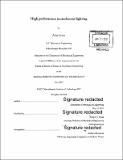High performance incandescent lighting
Author(s)
Leroy, Arny
DownloadFull printable version (14.27Mb)
Other Contributors
Massachusetts Institute of Technology. Department of Mechanical Engineering.
Advisor
Evelyn N. Wang.
Terms of use
Metadata
Show full item recordAbstract
The efficiency of incandescent light bulbs (ILBs) is inherently very low due to significant emission at infrared wavelengths, diminishing its market share rapidly. ILBs with cold-side filters that transmit visible light but reflect infrared radiation back to the filament can surpass state-of-the-art light-emitting diodes (LEDs) in both efficiency and light quality (color rending index; CRI). However, practical challenges such as filter and filament thermal stability, filament evaporation and imperfect geometrical alignment (view factor) between the filament and cold-side filter can limit the maximum achievable efficiency and significantly reduce the effectiveness of cold-side filters. In this thesis, we first present a review of existing approaches to improve the efficiency of ILBs such as selective filters and emitters for incandescent lighting. We highlight different challenges in achieving an efficient and long lasting bulb, and discuss previous approaches used to address these challenges in ILBs. We then present the modelling framework as well as the experimental setup and methods use throughout the thesis to study these problems. Second, we show that the effect of imperfect view factor between the filament and filter on the system efficiency can be minimized by combining a cold-side optical filter with a selective emitter. We experimentally and theoretically demonstrate energy savings of up to 67% compared to a bare tungsten emitter at 2000 K, representing a 34% improvement over a bare tungsten filament with a filter. Our work suggests that this approach can be competitive with LEDs in terms of luminous efficiency as well as CRI using selective emitters and filters already demonstrated in the literature, thus paving the way for next-generation high-efficiency ILBs. Third, we propose adding specular side reflectors between the filament and the cold-side filter to increase the view factor between the filament and filter which could further improve the efficiency of ILBs. We develop an analytical model to calculate the filament heat flux in 2-D and 3-D fully-specular enclosures consisting of a filament, a filter and side reflectors as a function of specular view factors and optical properties of the surfaces. Theoretical results show that significant improvements in luminous efficiency can be achieved using side reflectors in an ILB due to increased photon recycling. Our preliminary experimental results demonstrate an 18% reduction in filament power consumption after adding polished copper side reflectors, thus validating the potential of this approach. Finally, we highlight two remaining challenges to achieve a durable and efficient ILB using the current planar geometry with infrared filters and discuss ways to address them. The first challenge - the filter thermal stability, is numerically and experimentally investigated to optimize the filament temperature and system geometry for maximum system efficiency while satisfying the maximum filter temperature. Using a COMSOL model validated by experimental measurements, we find that the maximum achievable luminous efficiency in a best-case scenario (vacuum environment) is about 4.8 % when the maximum filter temperature is limited to 800 'C, only slightly higher than without infrared filters. We then investigate the second challenge - the high rate of tungsten filament evaporation and the resulting reduction in the ILB lifetime. We observe that the tungsten filament evaporation leads to rapid darkening of the filters primarily because of the low filter to filament area ratio, which limits the lifetime of the system to a few hours only. Lastly, we suggest system-level improvements that could help address these challenges and extend the lifetime of the ILB with cold-side filters.
Description
Thesis: S.M., Massachusetts Institute of Technology, Department of Mechanical Engineering, 2017. Cataloged from PDF version of thesis. Includes bibliographical references (pages 85-92).
Date issued
2017Department
Massachusetts Institute of Technology. Department of Mechanical EngineeringPublisher
Massachusetts Institute of Technology
Keywords
Mechanical Engineering.